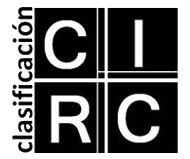The social representations of the officials of the judiciary towards European and South American migrations
between the authorities and prejudice
DOI:
https://doi.org/10.24215/16696581e455Keywords:
social representations, migrations, judicial power, interculturalityAbstract
This article investigates the social representations of AMBA Judicial Power officials regarding external migration (European and South American). The paper approaches the understanding of intercultural relations through the institutional voice of officials comparing the representations they have regarding European and South American migrations according to their idiosyncrasy and historical significance. The main findings indicate that the representations of the officials regarding these groups are strongly differentiated. The European migrations are assigned positive characteristics related to the construction of the nation and its identity due to the culture of work and civilized values while to the South American migrations, negative qualities are attributed, crossed by the exploitation, the crime and the I rooted in their own cultures. In this way, the article demonstrates that interculturality in the Argentine Republic is conflictive and antagonistic and that therefore, relations between natives and migrants are constituted as relations of domination. The research methodology is qualitative, and the research technique is the interview, individual and semi-structured. The data were encoded and analyzed according to the pillars of the Grounded Theory
Downloads
References
Bauman, Z. (2011). “¿Son peligrosos los extraños?” (págs. 75-100), en Z. Bauman, Daños colaterales. Buenos Aires: Fondo de Cultura Económica.
Becker, H. (2010). “Capítulo 1: Outsiders” (págs. 21-37), en H. Becker, Outsiders. Hacia una sociología de la desviación. Buenos Aires: Siglo XXI.
Benencia, R. (2003). La inmigración limítrofe, En F. Devoto, Historia de la inmigración argentina. Buenos Aires: Sudamericana
Buratovich, L, Lanzetta D, y Perez Ripossio R. (2016) “Representaciones sociales sobre el migrante externo: un análisis desde las intersecciones entre interculturalidad y clase social” En I Jornadas “Un siglo de migraciones en la Argentina contemporánea: 1914-2014”. Instituto de Investigaciones “Gino Germani”, Facultad de Ciencias Sociales, Universidad de Buenos Aires e Instituto de Historia Argentina y Americana “Dr. Emilio Ravignani”, Facultad de Filosofía y Letras, Universidad de Buenos Aires.
Ceva, M. (2006). “La inmigración limítrofe hacia la argentina en la larga duración” (págs. 17-47), en E. Jelin & A.
Grimson, Migraciones regionales hacia la Argentina. Diferencia, desigualdad y derechos. Buenos Aires: Prometeo.
Cohen, N. (2004), Las migraciones tradicionales y las migraciones recientes: percepciones diferenciales, En N.
Cohen, Puertas adentro la inmigración discriminada, ayer y hoy. (págs. 26-32). Buenos Aires: Kolesas.
Cohen, N. (2009), No solo es cuestión de inmigrantes: migraciones externas y exclusión social, En S. Goinheix, Conflictos y expresiones de la desigualdad y la exclusión en América Latina. Buenos Aires: El Aleph.
Cohen, N. (2014) Dominación y migraciones externas, en Revista Onteaiken, Año 9, Nº 17. Córdoba: CEA-CIECS.
Courtis, C y Pacceca, M I. (2007) “Migración y derechos humanos: una aproximación crítica al “nuevo paradigma” para el tratamiento de la cuestión migratoria en la Argentina“. En Revista Jurídica de Buenos Aires. Facultad de Derecho Universidad de Buenos Aires. Número especial: 183-200.
Devoto, F. (2003). Historia de la inmigración en la Argentina. Buenos Aires: Sudamericana.
Domenech, E. (2011). “Crónica de una 'amenaza' anunciada. Inmigración e 'ilegalidad': visiones de Estado en la Argentina contemporánea” (págs. 31-77), en B. Feldman-Bianco, L. Rivera Sánchez, C. Stefoni & M. VIlla Martínez, La construcción social del sujeto migrante en América Latina: prácticas, representaciones y categorías. Quito: CLACSO. Contemporáneas. Estudios para el debate. Buenos Aires: Ciccus.
Foucault, M. (2000). Vigilar y castigar: nacimiento de la prisión. Siglo xxi.
García Fanlo, L. (2010). Genealogía de la argentinidad. Buenos Aires: Gran Aldea.
García Fanlo, L. (2014). “Crisol de razas y argentinidad en el discurso de Octavio Bunge”. En Revista de Estudios Latinoamericanos, Vol. 12, Nº 4.
Goffman, E. (2001). “Estigma e identidad social” (págs. 11-55) // “Control de la información e identidad personal” (págs. 56-125), en E. Goffman, Estigma. La identidad deteriorada. Buenos Aires: Amorrortu.
González, A. (2013). Representándose al otro migrante: el poder judicial como institución estatal nacional. Derecho y Ciencias Sociales, Nº 8, pp. 111–131.
Grimson, A. (2006). “Nuevas xenofobias, nuevas políticas étnicas en la Argentina” (págs. 69-97), en E. Jelin & A.
Grimson, Migraciones regionales hacia la Argentina. Diferencia, desigualdad y derechos. Buenos Aires: Prometeo.
Halperin Donghi, T (1998) “Para qué la inmigración” (págs. 189-238), en H. Donghi (comp.), El espejo de la historia. Problemas argentinos y perspectivas latinoamericanas. Buenos Aires, Sudamericana.
Jodelet, D. (1986). “La representación social: fenómenos, concepto y teoría”. En Serge Moscovici (Compilador). Psicología social (pp. 469-494). Barcelona: Paidós.
Moscovici, S. (1979). El psicoanálisis, su imagen y su público. Huemul: Buenos Aires.
Pacecca, M. I. (2006). “Migraciones e Interculturalidad” (págs. 277-280), en Aldo Ameigeiras y Elisa Jure (comps.), Diversidad cultural e interculturalidad. Buenos Aires. Prometeo Libros.
Parkin, F. (1979). “Capítulo 4: El cierre social como exclusión” (págs. 69-108), en F. Parkin, Marxismo y teoría de clases: una crítica burguesa. Madrid: Espasa Universitaria.
Pottilli, J., Silverstein y Tavernelli, T (2009) “De la jerarquización de naciones a la clasificación de sujetos: representaciones que perpetúan un orden exclusor.” En Cohen, N (Comp.) Representaciones de la diversidad: escuela, juventud y trabajo. Buenos Aires: Ediciones Cooperativas
Scribano, A (2008). El proceso de investigación social cualitativo, Buenos Aires: Prometeo.
Strauss, A. & Corbin, J. (2002). Bases de la investigación cualitativa. Técnicas y procedimientos para desarrollar la teoría fundamentada. Colombia: Universidad de Antioquia.
Vasilachis de Gialdino, I. (2006). La investigación cualitativa. En Irene Vasilachis de Gialdino (Ed.), Estrategias de investigación cualitativa (pp.23-64). Barcelona: Gedis.
Walsh, C. (2010). Interculturalidad crítica y educación intercultural. Construyendo interculturalidad crítica, 75, 96.
Zizek, S. (2008). “La tolerancia represiva del multiculturalismo” (págs. 55-62), en S. Zizek, En defensa de la intolerancia. Madrid: Ediciones Sequitur.
Downloads
Published
How to Cite
Issue
Section
License
La aceptación de un original por parte de la revista implica la cesión no exclusiva de los derechos patrimoniales de los/as autores/as en favor del editor, quien permite la reutilización, luego de su edición (postprint), bajo una Licencia Creative Commons Atribución-NoComercial-CompartirIgual 4.0 Internacional (CC BY-NC-SA 4.0)
Acorde a estos términos, el material se puede compartir (copiar y redistribuir en cualquier medio o formato) y adaptar (remezclar, transformar y crear a partir del material otra obra), siempre que a) se cite la autoría y la fuente original de su publicación (revista y URL de la obra), b) no se use para fines comerciales y c) se mantengan los mismos términos de la licencia.
La cesión de derechos no exclusivos implica que luego de su edición (postprint) en Question las/os autoras/es pueden publicar su trabajo en cualquier idioma, medio y formato; en tales casos, se solicita que se consigne que el material fue publicado originalmente en esta revista.
Tal cesión supone, también, la autorización de los/as autores/as para que el trabajo sea cosechado por SEDICI, el repositorio institucional de la Universidad Nacional de La Plata, y sea difundido en las bases de datos que el equipo editorial considere adecuadas para incrementar la visibilidad de la publicación y de sus autores/as.
Asimismo, la revista incentiva a las/os autoras/es para que luego de su publicación en Question depositen sus producciones en otros repositorios institucionales y temáticos, bajo el principio de que ofrecer a la sociedad la producción científica y académica sin restricciones contribuye a un mayor intercambio del conocimiento global.
















































